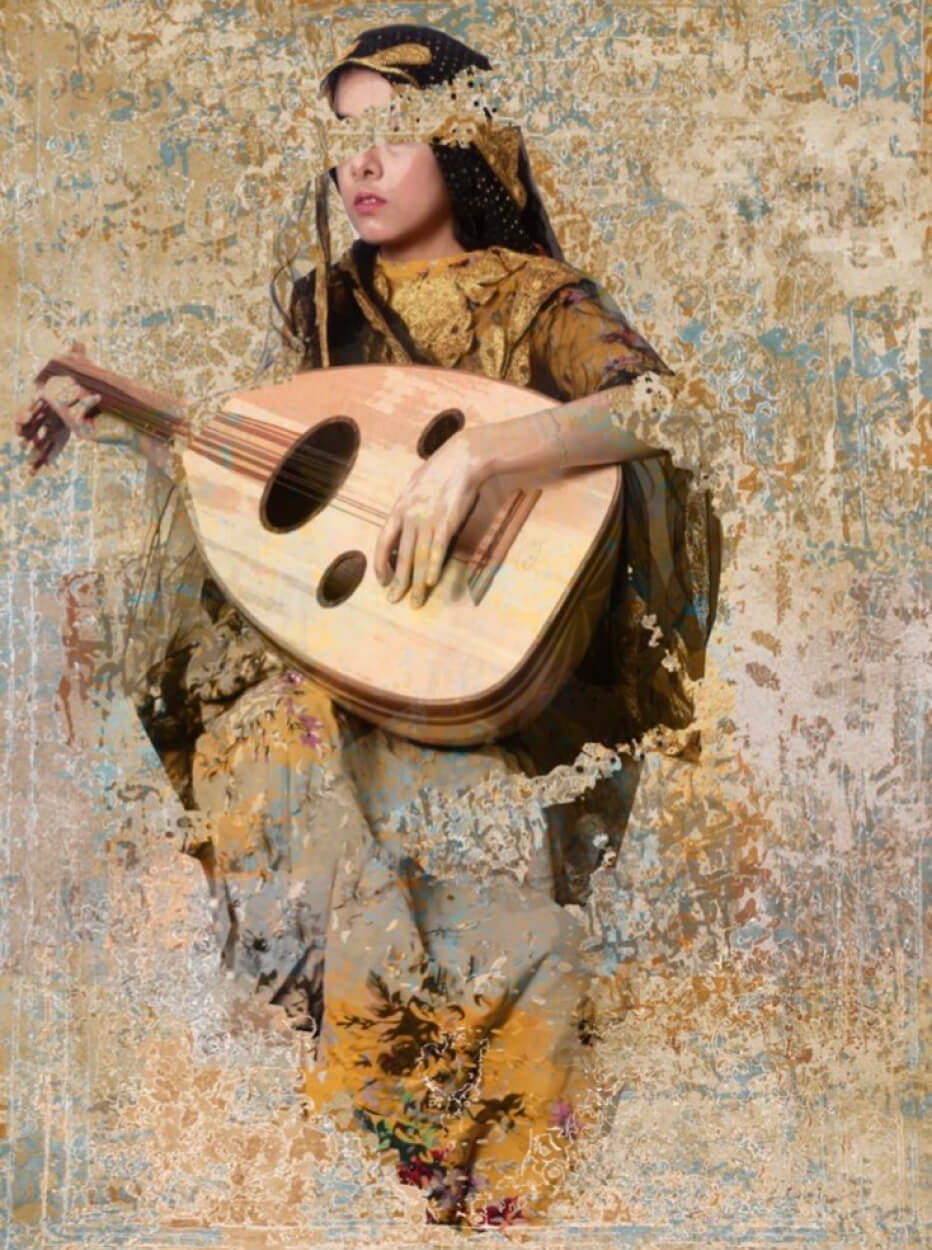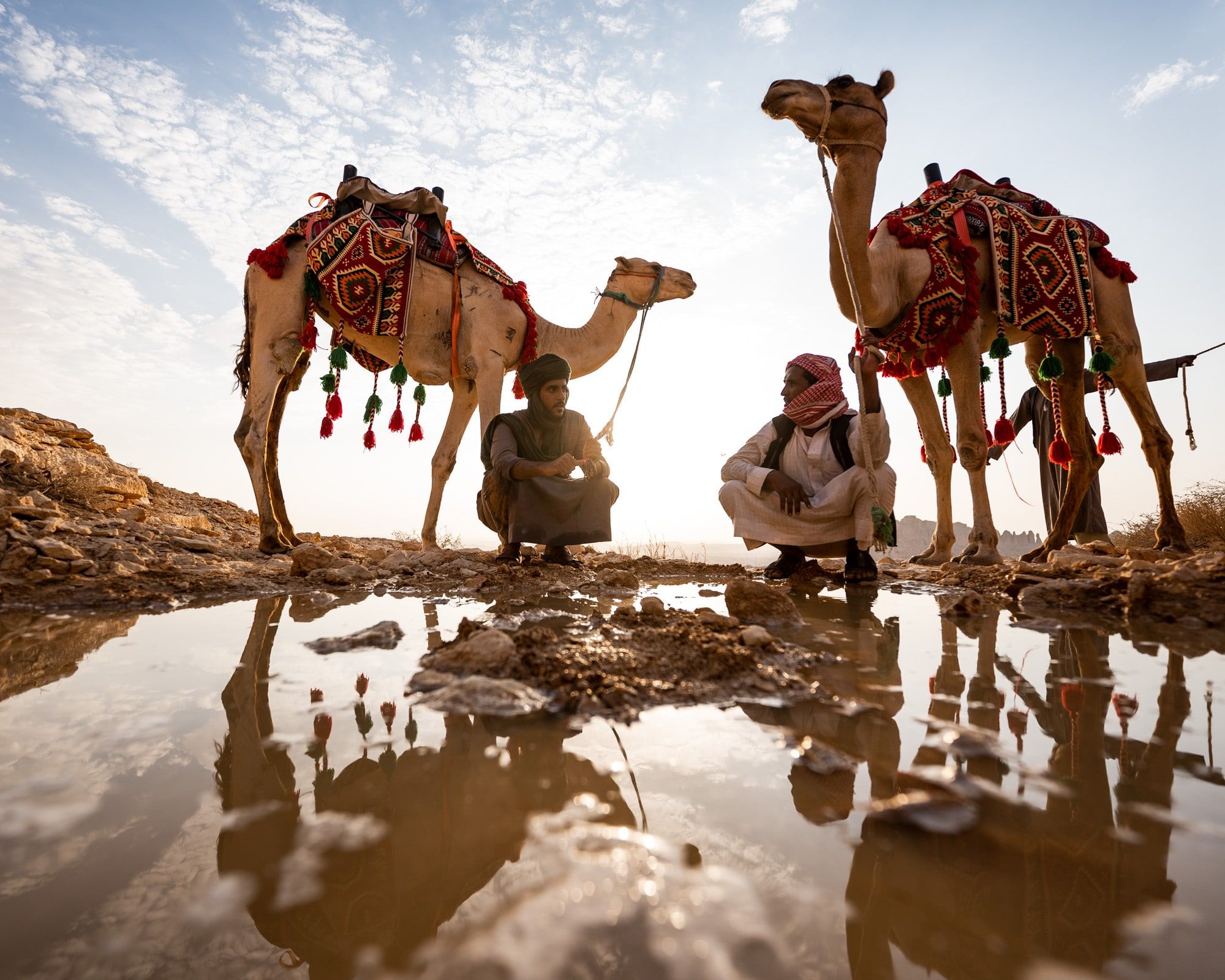Songs of Generations
Oud artwork, 140X 140 cm, Fatimah Al-Nemer. Courtesy of the artist.
The history of Saudi songs extend back decades before the establishment of the Saudi state, as each tribe had its own songs and chants. They were sung in peace or war time, or during happy occasions, and it was one of the most important components of the intangible heritage in the Kingdom.
It is difficult to determine the timeline for the development of the modern Saudi song, but studies in the history of music say that each tribe and geographic region had its own arts, such as the art of Majrour in Taif and the art of Al-Ardah in the Central Region, and the art of Hijazi (Al-Majs, Daq Al Hub, Al Liwa, Al Hasad and Al Farisah) in the Eastern Region.
In the early 1950s, the Kingdom underwent extensive transformations that radically changed the cultural face of the Kingdom and witnessed a major transformation in the field of music. The Saudi folk song had been isolated according to regions, geographically limited, its production capabilities were scarce, and musical instruments were rare, which prevented it from developing and renewing musical genres. Then it began to take on a more comprehensive field and fall under one umbrella called the modern Saudi song.
This lyrical transformation did not happen overnight, but we witnessed during that era many changes, innovations and renovations in the field of music in the Kingdom, and this change was led by great pioneers, who had unlimited creativity. They were led by Tariq Abdul Hakim (1918-2013), the Saudi musician and composer, then by Talal Maddah (1940-2000) and Muhammad Abdo (1949), whose roles and collective efforts made a major shift in the modern Saudi song, and took it to new horizons inside and outside the Kingdom. Thanks to their efforts, the Saudi song turned from a multicoloured traditional song into a song with clear features.
What is surprising is the success of the first generation of the early singers in leaving a firm imprint, and their songs were inherited by generations, withstood cultural changes, and became loved and known by all generations. They became an important component of Saudi and Arab culture, and part of the individual’s identity and conscience, and the common local culture that brings one together with their fellow citizens.
The Saudi song possesses strong elements and characteristics that contributed to making it stable in the face of changes and renewable over the decades. Even the songs that were composed and distributed in the early sixties are still present in the structure of the Saudi people and their collective musical memory. Everyone is still singing and humming songs such as, “Ya Reem Wadi Thaqif,” which was published in 1952 and sung by Tariq Abdul Hakim, and the song “Ta’alaqa Qalbi Tifla Arabiya” by Imru’ al-Qais, composed by Tariq Abdul Hakim. It was sung by the Lebanese singer Hiyam Younis, then by Talal Maddah.

Oud artwork, Fatimah Al-Nemer. Courtesy of the artist.
This list explores what the author considers the most prominent, modern and timeless songs that have taken root in the minds of the Saudi people and have succeeded in achieving fame and spread among the Arab public as well.
Abki Ala Ma Jara Li Ya Hali: This song was sung by Tariq Abdul Hakim and was written by Mohammed Al Suwailim.
Lan Allah: It was sung by Mohammad Abdo, composed by Tariq Abdel Hakim, and written by the poet Ibrahim Khafaji. It was first published in 1967, and this song is still capable of spreading feelings of joy and rapture among the masses every time it’s sung.
Ya Dar La Hinti Wala Han Ra’iki: It was written by the young poet Abdul Aziz Al Salem, and composed by Rabeh Saqr. It was published as part of his album; Rabeh 96, which was published in 1996. The song was one of the patriotic songs entrenched in the people's memory, as it succeeded in bringing together feelings of joy and celebration of pride in the country and its glories. It was not only a patriotic song, but it was present at weddings to kindle feelings of joy and mix them with patriotism and the overwhelming love for this country.
Ya Sariya Khabirini: A song of Hijazi folklore, which, with its smoothness and resonant lyrics, was able to go beyond being a folkloric song, to turn into a modern song while preserving its popular authenticity. It is still sung to the present day. It was composed by Lutfi Al Zaini (1939-2001), who was a poet, an actor and a producer.any Saudi and Arab singers sang it, including most recently the artist Myriam Fares.
Magadeer: Written by Mohammad Al Abdullah Al Faisal, and composed by Siraj Omar, it was recorded by Talal Maddah in Cairo, and it was among the first songs through which Maddah aspired to take the Saudi song to new horizons. It was also sung by the great singer Warda Al Jaza’iria. It was one of the songs laden with feelings of pain and suffering, and despite that, it left an imprint on the hearts of people in the Kingdom and abroad and succeeded in being a song strongly present in the memory of all generations.
Watani Al Habib: The writer of this exceptional and patriotic song which is immortal in everyone's memory is Dr Mustafa Balila, a teacher of architecture and engineering at King Saud University. He worked on radio during his university days in Italy. Talal Maddah sang this song full of feelings of love and devotion towards the dear homeland, and it was broadcast for the first time in 1961. It is considered the first patriotic song broadcasted to the people, as only hymns and chants were broadcast on official channels. It is considered one of the most famous patriotic songs that succeeded in going beyond being a mere song, to be an integral part of the people's memory and their national spirit.
Ya Tayeb Al Galb: It was one of the most important songs of Abdul Majeed Abdullah, which appeared in 1998, and left its mark in the world of video clips through its poetic and delicate lyrics. The song is still present in the current generation and loved by everyone.
What is beautiful and interesting about these songs is that they carry a lot of cultural importance, and they constitute one of the most important tributaries of musical culture and cultural bridges that connect the previous and subsequent generations, despite their experience of different social and cultural realities and changes. These immortal songs rise up and become more than just words and melodies sung, but rather a cultural and historical link between generations.
It challenges the conditions of globalization and the rapid cultural changes that came with the age of the Internet.
It is awe-inspiring that songs that were produced and sung more than half a century ago still resonate to this day. Truly they carry the collective sound memory that is transmitted across generations.


